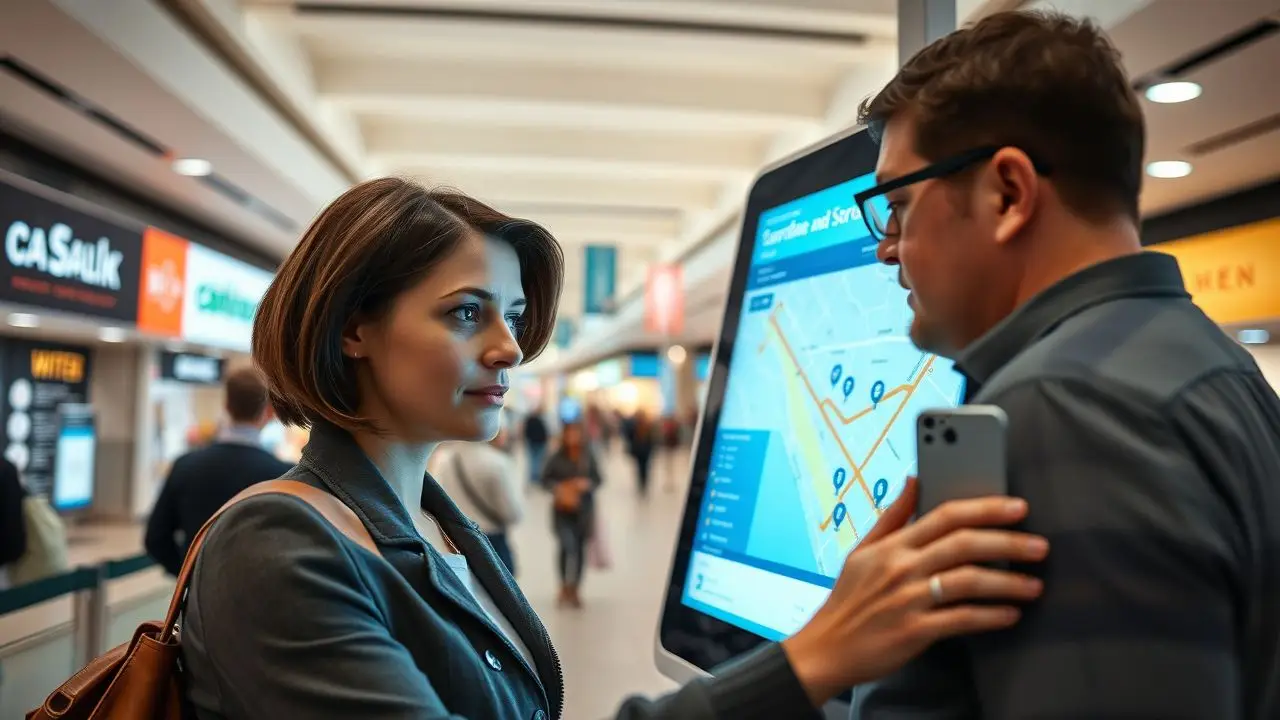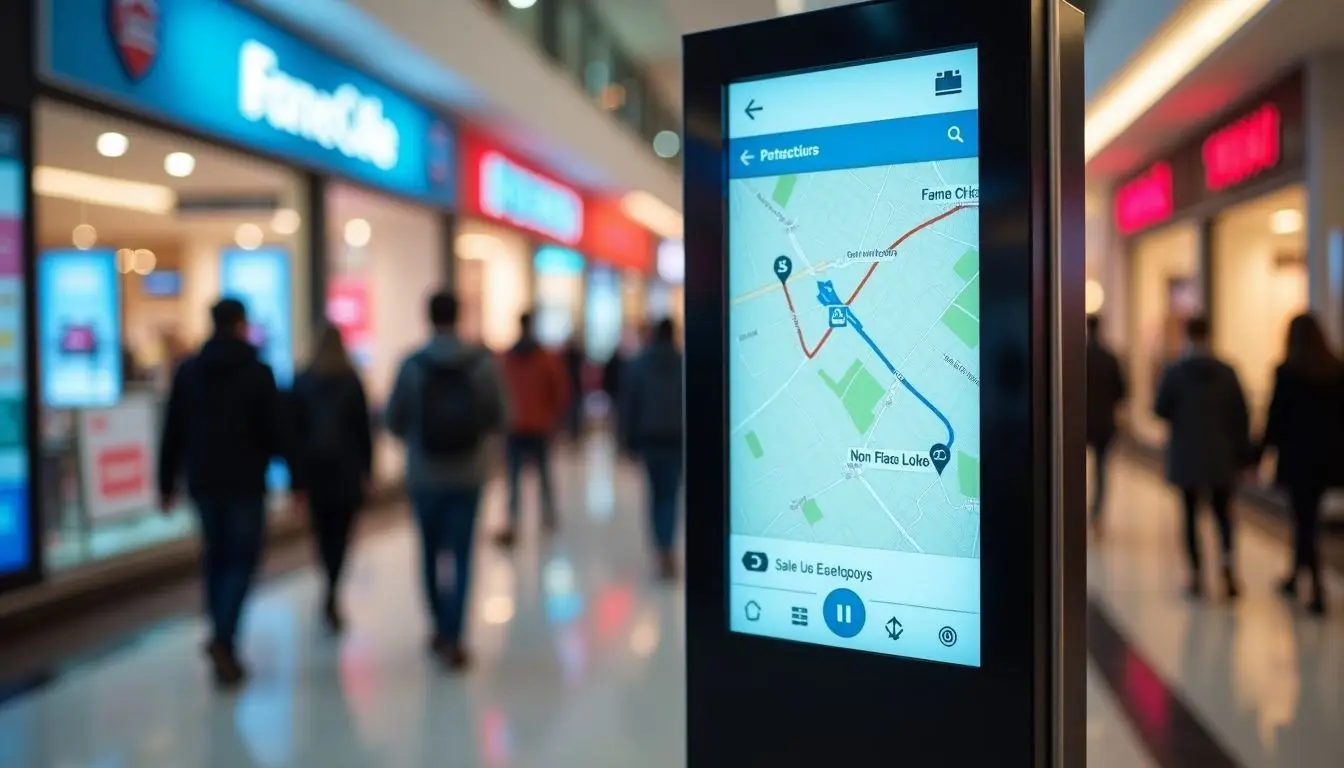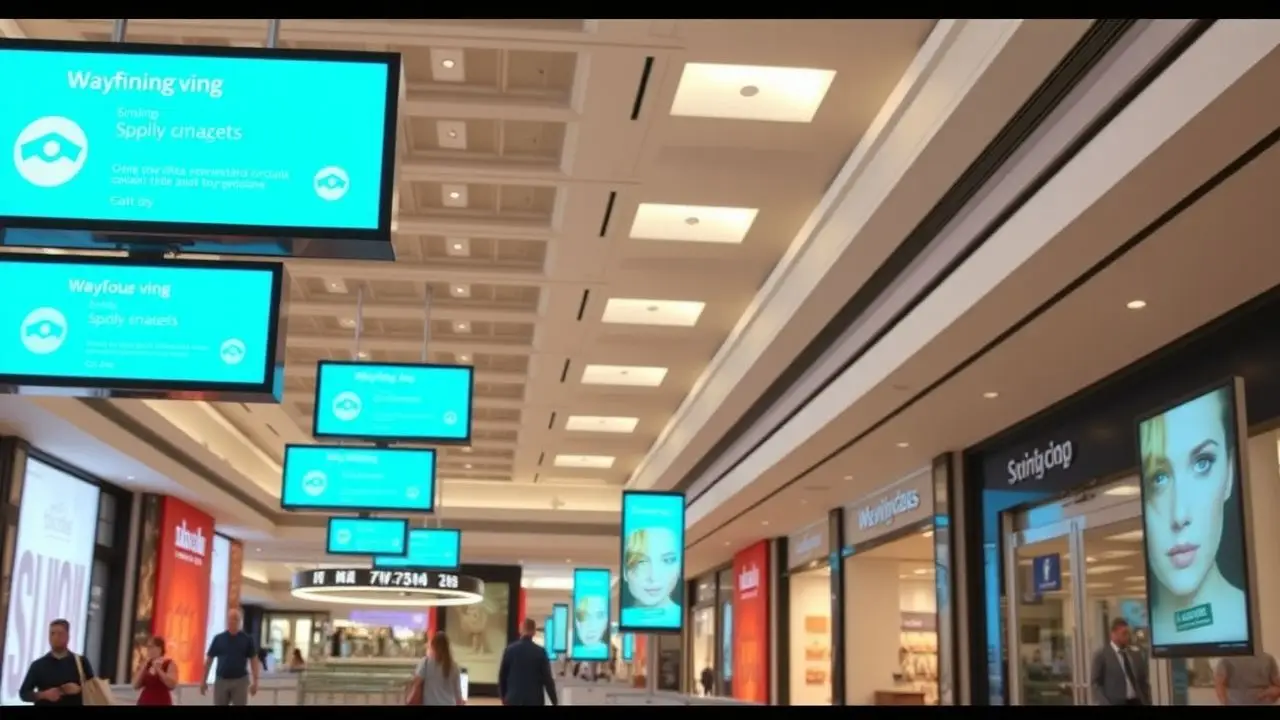Finding your way in a big shopping mall can be hard. Digital signage helps make this easier. Our blog shows how malls use electronic signs for wayfinding and promotions. Keep reading to learn more.
Key Takeaways
- Digital signs in malls help people find stores and deals.
- Screens like directories and maps guide shoppers easily.
- Signs also show ads for sales, making shopping more fun.
- Using digital signage makes malls run better.
- They save money by cutting down on paper use.
Table of Contents
ToggleTypes of Digital Displays for Shopping Malls

Shopping malls use many types of digital displays to guide shoppers. These screens help people find stores and promotions quickly and easily.
Digital Directories and Interactive Maps

Digital directories and interactive maps help shoppers find their way in malls. These displays show store locations, common spaces, and facilities like restrooms. They are easy to read and can guide visitors quickly.
Shoppers use them to see what shops are nearby or how far they need to walk. Interactive maps engage customers by letting them touch the screen for directions.
These tools improve the visitor experience in shopping centers. Retailers benefit too, as better navigation draws more traffic to their stores. Digital signage supports brand messaging by showcasing promotions and events alongside the directories.
For example, a shopper might discover a sale while searching for a specific store. This boosts revenue generation for both shops and malls alike.
Real-Time Wayfinding and Directions

Shopping malls use real-time wayfinding to help customers find their way. These systems show paths to stores, restrooms, and exits. Shoppers can get directions from digital displays in the mall.
This makes it easy for them to explore different shops.
Interactive signs also update information live. They can show sales or promotions happening nearby. Customers engage with these displays while shopping. Real-time wayfinding enhances the overall shopping experience and keeps shoppers informed about exciting retail promotions in the mall.
Interactive Touchscreens for Customer Engagement

Interactive touchscreens boost customer engagement in shopping malls. These displays allow shoppers to find stores, restaurants, and services easily. Users can explore maps and get directions with just a few taps.
Many malls use these screens for promotions too. Shoppers see ads for sales or new products while they search.
These touchscreens provide useful information in real time. They help visitors make better choices during their visits. Touchscreens enhance the shopping experience by making it more fun and informative.
A recent study found that interactive wayfinding increases foot traffic in stores by 20%. This shows how technology helps draw customers in and keeps them engaged.
Benefits of Digital Signage in Shopping Malls

Digital signage boosts the shopping experience. It helps customers find stores and promotions easily, making their visit more enjoyable.
Enhanced Shopping Experience

Digital signage greatly improves the shopping experience in malls. Customers can easily find stores and services with digital directories and interactive maps. These displays show real-time directions to help shoppers navigate the mall confidently.
Interactive touchscreens engage customers and make their visits more fun.
Bright advertising displays also catch attention. They promote sales, special events, and brand stories that entice shoppers. This boost in information helps people feel welcome and informed during their visit.
Digital marketing strategies keep customers engaged, making them want to explore even more of what the mall offers.
Increased Sales and Revenue
Digital signage boosts sales in shopping malls. It helps attract traffic and draws attention to promotions. Bright screens display ads that guide customers to stores with deals. This type of electronic signage makes it easy for shoppers to spot sales they might miss otherwise.
Using interactive displays keeps customers engaged. They can learn about products or find special offers quickly. As a result, more people make purchases, leading to increased revenue for mall shops.
A better customer experience connects shoppers with brands, which helps drive up sales even further.
Operational Efficiency
Digital signage helps shopping malls run better. Signs can show real-time updates and promotions. This speeds up communication with shoppers. Staff can receive alerts about events or changes quickly.
Everyone stays informed.
Using these signs cuts down on printing costs, too. Malls save money by not needing paper posters or flyers. Shoppers find what they need faster, which makes their experience smoother and more enjoyable.
Easier navigation leads to increased foot traffic and sales in stores. Engaging content attracts consumer attention as well, improving mall branding overall.
Strategies for Implementing Digital Signage in Malls

To make digital signage work well in malls, you must find the best spots for displays and select the right tools. Clear and engaging content will draw customers in. Keep reading to learn more about making this a success!
Identifying Ideal Locations
Identifying the best spots for digital signs is key for shopping malls. High-traffic areas, like entrances and food courts, are great locations. These places attract many visitors.
Signs placed here can guide shoppers and promote sales at stores.
Consider placing screens where customers naturally gather. Interactive maps can help them find their way. This boosts the shopping center enhancement by improving consumer behavior.
Effective placements make sure that information reaches as many people as possible.
Choosing the Right Hardware and Software
Choosing the right hardware and software is key for digital signage in shopping malls. First, select screens that are bright and clear. Customers need to see information easily in different lighting.
Interactive touchscreens can also engage shoppers better.
Software must be user-friendly. Staff should find it easy to update content. Real-time wayfinding needs accurate maps and directions. A good system will help customers navigate the mall smoothly.
It makes their experience pleasant while boosting traffic attraction for stores and promotions.
Creating Engaging Content
Creating engaging content is key for digital signage in shopping malls. Use bright colors and clear images to grab attention. Make sure the signs show useful information quickly. Include sales, events, or special offers to keep customers informed.
Interactive touchscreens can make a big difference too. They allow shoppers to explore stores and find deals on their own. For example, showing real-time promotions encourages more visits.
By making the content dynamic, malls enhance the shopping experience while driving up sales revenue through effective promotions.
Conclusion

Shopping malls use digital signage in smart ways. These displays help shoppers find their way and promote stores. They make the shopping experience better and boost sales. Digital signs also increase efficiency for mall operations.
Smart signage is a key part of modern malls today.
FAQs
1. How do shopping malls use digital signage for wayfinding?
Shopping malls use digital signage to guide customers around the mall. These signs help people find stores, restrooms, and other important spots.
2. Can digital signage be used for promotions in shopping malls?
Yes, shopping malls often use digital signage to promote sales or events happening in the mall. This is a great way to catch shoppers’ attention and inform them about special deals.
3. What are the benefits of using digital signage in shopping malls?
Digital signage can improve customer experience by making it easier to navigate through the mall and stay informed about promotions. It’s also an effective marketing tool for retailers within the mall.
4. Are there any challenges when implementing digital signage in shopping malls?
While beneficial, installing and maintaining these systems can be costly and time-consuming. However, many believe that the advantages outweigh these challenges.




